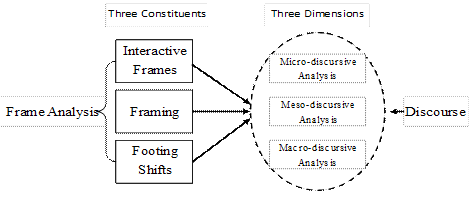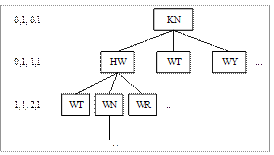A three-dimensional conceptual framework can be formulated in Figure 1, which serves the aim of the present research.

Figure 1 A Conceptual Framework of Frame Analysis
According to the theoretical framework, frame analysis can be conducted on the three dimensions which is favored by scholars like Fairclough (1992), van Dijk (1997a; 2001), Cotterill (2003) and so on to explore discursive practice.
Fairclough (1992: 85) maintains that micro-analysis and macro-analysis should be combined for the analysis of discursive practice. Complemented with macro-analysis, the former is the sort of analysis at which conversation analysts excel, and micro-analysis is the best place to uncover that information which provides evidence for macro-analysis, so micro- and macro-analysis are consequently mutual requisites (ibid). This opinion follows his three-dimensional framework (textual analysis, discursive analysis and social analysis), which can mediate the relationship between the dimensions of social practice and text: it is the nature of the social practice that determines the macro-processes of discursive practice, and it is the micro-processes that shape the text (see Fairclough, 1992).
van Dijk (2001) believes each role of a participant differentially affects discourse production which is involved in the contexts of social relations and cognition. Social relations may be expressed or enacted virtually everywhere in linguistic forms and pragmatic use, and cognition including ideologies is the very basis of a host of semantic and pragmatic properties of discourse.
As a matter of fact, Alvesson and Karreman (2000) happen to have an identical view as van Dijk’s. They hold that studies of discourse regarding the scope and scale of discourse include the following approaches. Micro-discourse approach focuses on language use in a particular micro context. Meso-discourse approach attends to language use in context but goes beyond the material in the text. Grand discourse approach emphasizes the dominating power of ideologies and their impact on organizational frames. Besides, mega-discourse approach addresses more or less standardized ways of referring to or constructing a certain type of phenomenon, e.g. courtroom practice. The first one is concerned with linguistic level, which is micro-discursive analysis; meso-discourse approach in fact refers to the analysis of discourse in van Dijk’s social context. The last two can be integrated into macro-discursive analysis corresponding to van Dijk’s cognitive dimension (van Dijk, 1997a, 2001).
2. Analytical Framework
A comprehensive analytical framework can be formulated as in Figure 2 which contributes to the concrete analysis of the data in this research.
Figure 2 An Analytical Framework for Exploring PDJ relationship
Discourse analysis can start with the identification of specific primary frames and sub-frames (see Table 1) in the interaction, which involves the variables on the three dimensions we have conceptualized above.
Table 1 Signature Matrix for Frame Identification and Framing
Through the description of judges’ criminal courtroom discourse, we will focus on information knots, information levels or catchphrases at the linguistic-levels since frames are incarnated by the discursive content (Benford, 1997). Here catchphrases refer to the key words or other special phrases as contextualization cues. Social variables mainly include criminal courtroom settings, social relations, laws and regulations and so on. Settings and relations are the major components in frame structure while laws and regulations belong to frame convention (van Dijk, 1977a), so the examination of those variables provides the supportive context analysis for the linguistic investigation. Knowledge categories, perception of justice, ideologies etc. constitute the cognitive variables in the identification of specific frames, which can serve as the other components of frame convention (van Dijk, 1977a).
Overall, the reification of frames will be accomplished by the exploration of discourse information chunks in both social and cognitive contexts.
The second concern in Figure 2 is the factors that influence the PDJ relationship constructed in the courtroom. We will make the description of the extent to which the PDJ relationship is corresponding to the three core dimensions of judicial justice. Based on interactive frames, footing and framing, we will then explain various factors concerning legal system, cultures, knowledge schema, ideology, power, etc. We conduct the investigation of interactive frames and framing according to the signature matrix in Table 1 and explore specific footings in virtue of participation framework (Goffman, 1981).
Unquestionably, judges’ framing strategies in the construction of PDJ relationship are the ultimate purpose of the research. The strategies should be put forward aiming at the foregoing description and explanation of the phenomena and reasons. All the factors influencing PDJ relationship have always been embodied by discursive practice in trials, so have framing strategies. With the shifts of frames, judges adjust their discourse information to the process of a trial, which reflects whether PD balance can be kept, whether judges preside over the trial neutrally, and whether justice on the three dimensions is maintained. We categorize these strategies and interpret which should be reserved, which should be discarded and which should be amended so as to help construct rational PDJ relationship.
In the next section, we will present research methodology for the present study and explain how the data are collected and analyzed.
The data analysis will be implemented in the light of the analytical framework we have constructed above. Since all the data have been sampled from the CLIPS, Tree Information Structure of Legal Discourse will be exploited and integrated with other analytical tools based on frame analysis. We will categorize judges’ discourse according to information types, considering the context of each information unit as well.
For each legal discourse, we can identify the kernel proposition (KN) and its subordinate information units. Therefore, the information structure of a legal discourse can be displayed as a tree diagram like the one in Figure 3. Every information unit corresponds to an information knot in the tree diagram. Besides interrogative words, the tagging of information units also includes level codes, information source and knowledge categories.

Figure 3 Tree Information Structure of Legal Discourse (Du, 2009)
Level codes are composed of level number and position number of the information knot and its superordinate information knot. In Figure 3, KN (kernel proposition) is the information focus of the whole discourse. It is at the top of the tree structure, so we give it the level code ‘0,1,0,1’. It is developed into subordinate information knots, in this figure HW, WT and WY, at the first lower level. Their level codes are ‘0,1,1,1’, ‘0,1,1,2’ and ‘0,1,1,3’ respectively. Knot HW has its own subordinate knots WT, WN and WR, the level codes of which are ‘1,1,2,1’, ‘1,1,2,2’ and ‘1,1,2,3’. ‘1,1,2,3’ means knot WR takes up the third position (tagged as 3) at level 2. It is subordinate to knot HW which is at the first position (tagged as 1) of level 1.
It will be an attempt made for the present research that the two micro-analytical tools are combined with tree information structure of legal discourse. The integration of information levels and information units with turn-taking and interruptions is useful to explore how frames are articulated in the courtroom and how they interact with each other along the progress of discourse.
Information level and information knots will also be employed to parse judges’ discourse and detect how judges evaluate or identify legal facts. At the same time discourse processing can be best interpreted through context analysis (van Dijk, 1992), which can be utilized to explicate the relations between information units and legal contextual variables. Such an analysis serves both the exploration of interactive frames and the inquiry about judges’ discourse processing and discursive strategies.
The second concern in discourse analysis is social context in which discourse is produced as frames are socially enacted by discourse (Creed, Langstraat & Scully, 2002). As a conceptual tool, frame analysis is particularly suited for understanding how people construct meaning from moment to moment (Ribeiro, 2006). As discourse is being produced, understood and analyzed relative to such context features as participants, their roles and purposes, as well as properties of a setting (van Dijk, 1997b), judges’ discourse does not appear in vacuo and the study cannot be independent of such social factors as social power, social relations, social status and social role. The meso-discursive analysis will elucidate how judges perform their duties through the information exchange and clarify whether symmetry/asymmetry exists in the process of courtroom information flow.
Since the study of legal language is based on the social context (Du, 2004), interactional sociolinguistics, a useful analytical tool, can be applied at the meso-level to explore shifting frames (Gumperz, 1999). It has contributed a series of tools that can be used in the interpretative and inferential analysis of the data (Prego-Vázquez, 2007). For example, the study of contextualization cues is crucial in order to explain how frames shift in the interactions studied. Thus it has enabled us to observe the way in which social order is built up from interactional order, revealing the role played by frames, linguistic resources and interactional asymmetry in reproducing the power differences that separate institutions and citizens (Prego-Vázquez, 2007).
Thirdly, we also need to extend our analysis into macro-context in which cognitive factors will be involved. The discursive level of discourse represents more than the sum of the individual parts of sentences and fragments in text, but at some point, the researcher must draw inferential conjectures about ‘black box’ operations of the human mind to identify the markers of the frame in the text (Fisher, 1997). The outstanding achievements made in the cognitive research dwell in analyzing cognitive process of discourse, thus a series of models and important concepts have been put forward like schema (Rumelhart & Ortony, 1977), frame (Minsky, 1975), script (Schank & Abelson, 1977). Besides cognitive analysis from the psychological perspective, macrostructure (van Dijk, 1977b; van Dijk & Kintsch, 1983) has been brought into the cognitive analysis from discursive perspective and a comprehensive research has also been made in discourse comprehension strategies (van Dijk & Kintsch, 1983). So we need to make cognitive analysis which concentrates on the psychological representation and emphasizes the analysis of macro-discursive structure and discursive structural elements (e.g. propositions and propositional network) (Du, 2008a).
Since the frames that give form to our experience are cognitive and are grounded in strips (Smith, 2006), judges choose the corresponding types of discourse information to construct frames. As a result, knowledge categories can be adopted to study how judges make their articulated and shifting frames accepted by other participants in court. For example, judges will construct a frame to organize a trial, in which certain expressions can be perceived and accepted by other participants as the activity of controlling the trial, because this activity may be existing as ideology in the social cognition shared by social groups (van Dijk, 2001).
In conclusion, we will begin our analysis with the linguistic features of discourse, which pin down the context in which discourse is produced. Thus, both social and cognitive factors will be involved in scrutinizing judges’ discourse.
